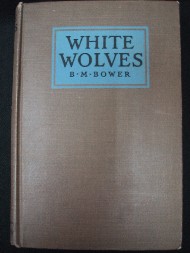Lawrie Brunelle, a tenderfoot artist on his way back to Meadowlark Ranch, had only a shadowy glimpse of the three cattle-thieves driving their plunder into the black, wooded canyon of the valley below the trail. Wolves –human wolves—were stealthily riding the Missouri range, coolly robbing from the outlying herds.
This was the under side of range life –the local color Lawrie had come West to paint. Back at the ranch, he made a symbolic picture of the vivid scene … white wolves, with men’s faces –modeled after those of the neighborhood cow hands – driving cattle away. He was wholly unprepared for the hot resentment of the Meadowlark riders who were convinced that this was the artist’s way of accusing those friends whose faces he had painted on his canvas of being rustlers.
Unaware that his painting actually held evidence that could be used against the guilty, Lawrie left Meadowlark for a small island in the river where he settled down to raise cattle and paint. Even here he could not escape the wolves for Lawrie would remain a menace to them so long as they were uncertain how much he had really seen.
When Kid Kern, an outlaw, chose Lawrie’s island as a hide-out from the sheriff, the wolves were drawn closer, endangering not only the young artist, but Penny, the girl he loved, as well.
There are many unforeseen hazards and surprising discoveries before Lawrie and Penny outwit the gang ---wolves who by nature and training were more deadly because they were white.
|
